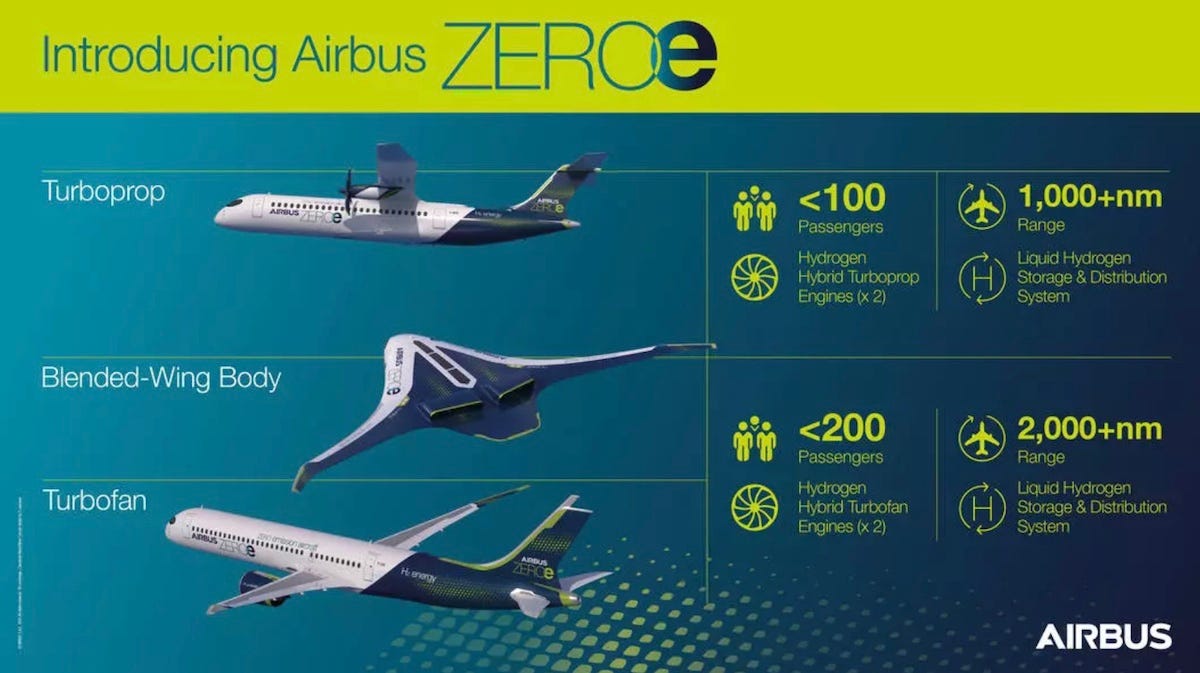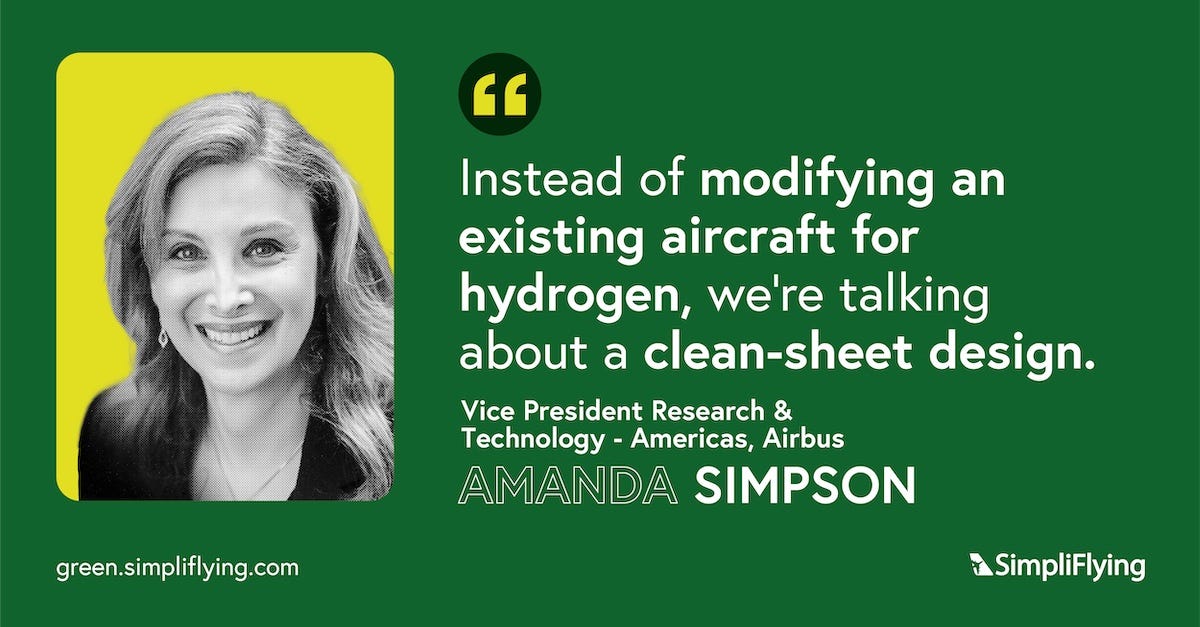Welcome to Season 3 of Sustainability in the Air, the world’s first podcast dedicated to sustainable aviation. Through in-depth conversations with top aviation leaders, we break through the clutter and provide a clear roadmap for a net-zero future.
As the largest aircraft manufacturer in the world, Airbus is in a unique position to drive aviation towards a zero-emission future.
In this episode of our ‘Sustainability in the Air’ podcast, Airbus’ Vice President for Research & Technology (Americas), Amanda Simpson speaks with SimpliFlying CEO Shashank Nigam and shares how the airframer is at the forefront of investing in new technologies and innovations that pioneer the sustainability spirit.
Before she joined Airbus, Simpson served as the Deputy Assistant Secretary, Operational Energy at the United States Department of Defense. She was also the Executive Director of the US Army Office of Energy Initiatives. As a skilled pilot and engineer with nearly four decades of industry experience, Simpson’s areas of expertise include advanced technology, aerospace and defense, aviation, test and evaluation and energy.
You can listen and subscribe to our podcast on all major podcast platforms or read our deep dive into the episode below.
Betting on hydrogen (3:38)
Hydrogen combustion vs hydrogen electric (5:35)
Why batteries are a short-range solution (7:15)
Project Blue Condor (8:45)
Will hydrogen as fuel lead to a payload penalty? (12:17)
Why clean-sheet designs may be the answer (14:18)
Addressing the infrastructure challenges with hydrogen (16:28)
What role will SAF play? (19:20)
The future prospects of eVTOLs (23:50)
Five approaches to net zero (25:32)
Rapid Fire (28:17)
Heavy on hydrogen
Airbus, Simpson begins by saying, is pressing forward as hard as it can to meet not only external goals but even more aggressive internal goals. “Aviation might only be about 2% of carbon emissions today. But as all the other sectors work to decarbonise, if we don’t do anything, that number will grow and become unmanageable”, she warns.
Simpson says that over the past decade Airbus has tried a variety of different technologies, either through demonstrators or paper studies. The end result is that the company now firmly believes that hydrogen has the potential to offer a true clean fuel solution to not just aviation but other industries as well. “When you utilise hydrogen, the only byproduct is water”, states Simpson. “So we determined that that’s the way that the aerospace industry has to go.”
In 2020, Airbus revealed three concepts for zero-emission commercial aircraft that could enter service by 2035. The three concept aircraft – all code-named “ZEROe” – rely on hydrogen as a primary power source. In early 2022, Airbus announced the ZEROe demonstrator that will test the potential of hydrogen-powered commercial flights on a modified A380 platform.
To combust or turn electric, that is the question
Airbus has set itself apart from others in the hydrogen space by firmly betting on hydrogen combustion as the way forward. Others, such as Universal Hydrogen and ZeroAvia, for instance, rely on retrofitting existing aircraft with hydrogen-electric power trains. (Universal Hydrogen recently completed a major test flight on a Dash-8 fitted with the largest ever hydrogen fuel cell.)
Simpson is appreciative of their efforts and says that Airbus fully supports their endeavours. However, she is quick to note that because these companies are modifying existing aircraft and leveraging existing technologies, the efficiency isn’t at the level Airbus believes it needs to be in order to have a viable commercial aircraft. Which is why Airbus is pushing ahead with testing new concepts, especially since today’s jet turbines aren’t designed to handle hydrogen combustion.
That said, Simpson says Airbus is “absolutely in line with hydrogen-electric”. In fact, Airbus recently announced a fourth concept aircraft as well as its progress on developing a hydrogen electric fuel cell pod. The company’s official statement says that Airbus has been conducting studies and tests to realise a fully working megawatt-class fuel-cell engine and demonstrator which could be tested in flight by around 2026.
No electric, no cry
At Farnborough 2014, Airbus showcased the all-electric e-Fan prototype aircraft that was expected to enter service in the next few years. However, in 2017 Airbus cancelled the programme and announced that it would instead develop hybrid-electric jet aircraft to support regional flights, with an expected entry into service by 2030.
Simpson appears lukewarm about the potential of hybrid-electric technology for large aircraft propulsion. While she believes the technology will have its place in aerospace, she believes battery issues around weight and energy density will severely limit its potential. “So with batteries only, you’re going to see some of the upcoming Advanced Air Mobility vehicles with just a few seats, a very limited range and very limited payload”, she states.
Although Airbus is working on those as well – through the Vahana and CityAirbus eVTOL demonstrators, for example – Simpson re-iterates that the company now believes that hydrogen can truly support the electricity needs for the mid- to short-range aircraft in ways that today’s battery technology cannot. “Right now, that’s kind of the limiting factor – the size of an electric motor that you can put on an aircraft”, she says. “And then of course, hydrogen combustion, that’s going to run the larger aircraft that is going to fly in the future.”
“We want to find the most viable solution that we can apply to the new generation of airliners that we’ll have to start building in the next several years.”
Hydrogen: fuel of the future or just gas?
While Airbus’ championing of hydrogen promises to change the nature of flying forever, the Hydrogen Science Coalition wants us to hold our horses. By a back-of-the-envelope estimate, there is likely to be a 15 to 20% payload reduction on a Boeing 787 running on liquid hydrogen as compared to Jet A fuel.
Simpson says that the numbers can be tricky to crunch while equating jet fuel to hydrogen. For example, every kilo of hydrogen contains three times as much energy as an equivalent unit of jet fuel. So only about one-third of the weight of fuel will be required. However, hydrogen takes up much, much more volume (the gas is 8972 times less dense than jet fuel). Even after compressing and liquefying, hydrogen takes up four times the volume of jet fuel.
In order to store the liquid hydrogen, one needs cryogenic, super cold tanks that are extremely heavy. The weight of the tanks becomes an issue. Simpson agrees with the basic calculation: “if you’re going to try to put all of that weight into an existing airframe, you’re going to have a payload penalty.”
However, Simpson argues that if an aircraft is designed from the outset to meet particular performance parameters, flight range, and payload capability based on a hydrogen propulsion system, there won’t be a weight penalty. Airbus is focusing on clean-sheet design for this very reason, so that they can focus on delivering the benefits of hydrogen without being hamstrung by existing aircraft designs.
Five approaches to net zero
Simpson believes that aviation is investing significant effort and resources to get to net zero. She highlights five approaches that aviation must pursue simultaneously to decarbonise as fast as possible:
Sustainable Aviation Fuel (SAF): While SAF is considered the most promising contribution for aviation sustainability, it is not without its limitations. SAF remains in short supply and currently accounts for less than 1% of all available fuels, and does not fully eliminate carbon and other harmful emissions. Transitioning from conventional fossil fuels will require rapidly scaling up the development and production of SAF.
New Technologies: In the medium- to long-term, technologies like hydrogen and advanced aerodynamics will be effective solutions. However, these technologies are unlikely to have matured before the mid-2030s, Simpson adds.
Optimising air traffic management systems: Using advanced artificial intelligence and computing techniques in air traffic management systems to optimise routes, schedules and flying times will help streamline the process and reduce fuel wastage.
Offsets: It is not possible to get to net zero with technologies and SAF alone, as neither option is 100% efficient, says Simpson. While SAF can offer up to 80% recycle rate, the remaining 20% needs to be offset through direct carbon capture or planting trees, and even then getting to net zero might be a little far fetched.
Fleet renewal: Replacing and updating older aircraft can have the biggest impact in the short-term. The aircraft rolling off production lines today offer about 15%-20% emissions reduction compared to aircraft produced only 5 years ago.
Our Take
Aircraft are the very basis of aviation. While the quest for innovations to decarbonise aviation continues, making aircraft efficient remains one of the most promising near-term solutions. There is hardly any doubt then about the responsibility that falls on airframers.
The aviation industry is heavily fossil fuel dependent and there are no clear alternatives to decarbonise effectively. The industry often faces severe backlash from climate activists who accuse it of being negligent and wasteful at its very core. While these accusations are not unfounded, air travel cannot be wished away or asked to shut shop. We need to embrace available solutions while investing in newer innovations.
While there is much excitement about the potential of various technologies to help the industry reach net zero by 2050, Simpson is right to strike a cautious note about the importance of thinking long-term. Today’s aircraft – many thousands of them – will still be around for another 20-30 years. As much as we’d like green aviation to become a reality, we need to be pragmatic. The climate crisis wasn’t seeded in a day, and its cure isn’t likely to arrive in a day either.
Our Sustainability in the Air podcast is powered by SimpliFlying which has been helping build trust in travel for over a decade.
This season of the podcast is brought to you by Cirium and CarbonClick. As a sustainability partner, Cirium helps the aviation industry gain a much clearer view of carbon emissions and develop methods to reduce them, enabling on the industry promise to fly sustainably. CarbonClick is the industry leader in managing transparent carbon offsetting programs for individuals and top global airlines.















